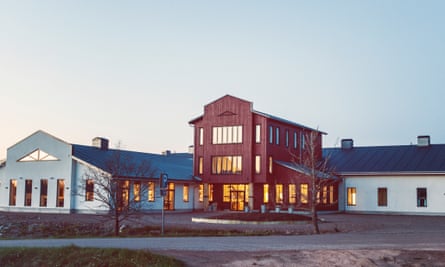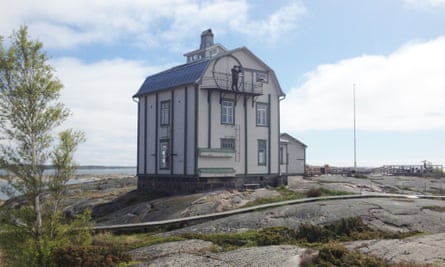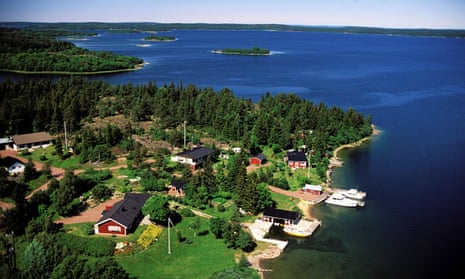At midnight there is a long orange streak of sunset across the horizon and the colour of the sky is just past dusk. As we wait for the last ferry back to Helsinki, there are tantalising strains of nightclub music and the raucous, drunken, happy noise of young people, who have just graduated from college, walking along the harbour, looking for a bar. Later, when the ship leaves, the green silhouettes of the islands we’ve been staying on are visible in the fading light long after midnight.
This disorientating feeling of the Nordic white nights makes a holiday on the Åland islands unsettling and unusual. It is light when you go to sleep and dawn if you wake at four in the morning; no one feels inclined to sleep too much.
The autonomous Åland archipelago – a patch of around 7,000 islands, halfway between Finland and Sweden – is a Nordic holiday playground where people come to cycle, kayak, sail, fish, swim in the cold Baltic Sea and warm up in saunas afterwards. The islands are Swedish-speaking but attached to Finland, and families from both countries come here from early June to late August, renting wooden cabins by the sea. But in late May, it is empty.
We stay for two nights in a log cabin in a small forest next to the sea on the main island, Fasta Åland. A few other cabins are visible across the water, but otherwise it is deserted, apart from nesting swans. It is a 20-minute cycle ride from Mariehamn, the port town, where it is easy to rent bicycles at Ro-No and roam south to smaller islands, which are connected by narrow bridges. The town is pretty, with old wooden buildings, painted in yellows, greys, violets and blues, with the windows, doors and porches in contrasting colours. Its architecture is reminiscent of a 19th-century provincial Russian town. This isn’t surprising, since the islands once belonged to Russia, and Mariehamn is named for the Russian Empress Maria Alexandrovna, who also gave her name to St Petersburg’s Mariinsky theatre.
When you leave the town, you follow main roads but these are so empty that it doesn’t feel perilous, even with relatively young children (eight and 10). The route to the islands of Nåtö, Granö and Järsö is lovely, with water on both sides, and views on to small islands, dotted with wooden houses in rusty red and yellow, and boat huts poking out between the rocks and the trees.
It is probably better to embark on these protracted rides (25km round-trip) with two adults. Taking the children alone, means all the weight of encouraging, chivvying, haranguing and nagging to keep going falls on one person (me). We’re always glad to retreat to our wooden cabin, turn on the wooden sauna and sit inside it until we feel warm again.

We also enjoy the Mariehamn public steam room, swimming pool and sauna), where a lot of children are being initiated by their grandmothers into the routine of sauna, steam room and a swim in the pool and through a plastic curtain that allows you to continue swimming outside in the fresh air.
The island food proves useful for restoring energy levels. Åland pancakes – a solid slab of semolina, milk, sugar and cardamom – help boost morale in the face of icy winds. Hot karjalan pies, which are a bread roll with rice paste, are also cheering, and I particularly like the Finnish salmon, dill and potato soup, lohikeitto, and some mashed potato topped with crayfish that we eat in Smakbyn, a restaurant that celebrates Åland food.
You need to take a boat to the further islands, which aren’t connected by bridges. Kobba Klintar has an old pilot station in a lonely white-panelled house on the desolate rocks. This was a look-out station, where sailors were employed to wait for ships to arrive, so that they could help navigate them into Mariehamn harbour. Occasionally, when too many ships arrived in stormy weather, there weren’t enough pilots, and craft would crash on the rocks. As a result, the Åland region has become a popular wreck-diving area.
After two days, we travel north to Saltvik, to a B&B in a beautiful, restored, 19th-century wooden villa which used to belong to the owner of the first bank of Åland. It looks on to a 12th-century church, and is a five-minute walk from a lake surrounded by tall rushes. There is a recreation of a Viking encampment five minutes’ walk in the other direction, where school children come for history lessons. We watch them being instructed in Viking life, and admire the longboat that villagers have been building for the past three years. The children then start doing a strange Viking dance in their costumes … but it turns out to be Psy’s Gangnam Style. It is a mystifying globalised experience.
This is the most relaxing day of our trip, where the most strenuous activity is walking to the village bakery to sit eating cinnamon buns and cakes with cranberries and cream cheese, and soaking up the magical scenery.

Tove Jannson, the artist and writer who created the Moomin series, loved the Åland archipelago and spent her summers on Källskär island, further south. You can see how the remote, wild Åland islands might have inspired her. It is a place that lingers in the imagination.
Flights were provided by Norwegian Air (norwegian.com), which flies from Gatwick to Helsinki from £54 one way. Accommodation was provided by Alands Resor (alandsresor.fi/kungsnas), which has cottages for five in Jomala from €225 for two nights, and by Kvarnbo Gästhem (kvarnbogasthem.com) in Saltvik, which has doubles from €92. Overnight ferries from Helsinki to Åland (vikingline.com) costs from €45 one way
Not so noir: more Nordic family adventures
Budget camping, Denmark
Denmark’s tourist office is on a drive to promote the country as a budget family holiday destination and advertising free camping spots in farms and forests across the country, aimed at people travelling by bicycle, horse or foot.
visitdenmark.com
Bear watching in Kuhmo, eastern Finland
The forests and lakes of Wild Taiga in eastern Finland are one of Europe’s last wilderness areas and home to wolf, lynx, bear, elk and reindeer. Families come for the wildlife, hiking, husky trekking, kayaking, and lake swimming. Hotel Kalevala is a family-friendly base near the town of Kuhmo from where Guild Travel offers a three-night brown bear watching trip to Kuhmo (from £879pp).
guildtravel.com
Horse riding with children, Swedish Lapland
Children over 12, or confident younger riders, can explore the Grand Nikkaluokta trail inside the Arctic Circle. In the summer, this can include camping under the midnight sun.
visitsweden.com

Comments (…)
Sign in or create your Guardian account to join the discussion